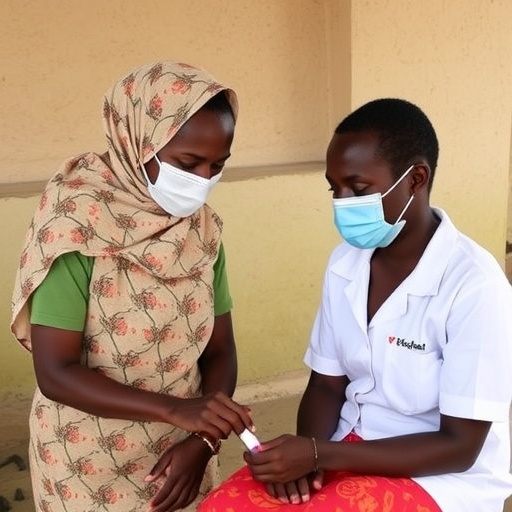In a significant advancement for cervical cancer screening, a recent study published in BMC Health Services Research explores the acceptability of home-based HPV self-sampling among users and healthcare providers in the West region of Cameroon. This research highlights a pivotal shift in how cervical cancer screening can be made more accessible, especially in low-resource settings where traditional screening methods may pose logistical challenges.
Cervical cancer remains one of the leading causes of cancer-related deaths among women worldwide, with over 300,000 fatalities reported annually. The disease is primarily caused by persistent infection with high-risk human papillomavirus (HPV) types, making HPV screening crucial for early diagnosis and treatment. Unfortunately, many women, especially in rural areas, face significant barriers to accessing conventional screening methods, which often require clinic visits and prolonged waiting times for results. In this context, home-based self-sampling presents a promising alternative.
The study conducted by Moukam et al. assesses both users’ and providers’ perspectives on the feasibility and acceptability of this innovative screening method. Utilizing a cross-sectional design, the researchers gathered data from a diverse cohort comprising women eligible for cervical cancer screening and healthcare practitioners involved in women’s health. This dual approach enriches the findings, ensuring that both user experiences and provider insights shape the discussion around home-based sampling.
Participants reported a variety of benefits associated with home-based HPV self-sampling. The convenience it offers cannot be overstated; women can conduct the test in the privacy of their homes without the stress of scheduling appointments or the stigma sometimes associated with clinic visits. This aspect is particularly significant in conservative communities where discussing reproductive health issues may carry social taboos. The research team highlighted that user empowerment through self-sampling could lead to increased participation in regular screening, ultimately improving cervical cancer prevention efforts.
Health providers, on the other hand, recognize the potential of this method to reach populations that are typically under-served or reluctant to engage with the healthcare system. Many expressed enthusiasm over the possibility of integrating self-sampling into existing programs, suggesting that it could enhance outreach efforts and streamline the screening process for women. This study taps into a growing body of evidence suggesting that self-sampling methods could effectively complement traditional screening approaches.
However, the study does not shy away from addressing the challenges that accompany the implementation of home-based self-sampling. While many users expressed strong acceptability, concerns arise regarding the accuracy of self-collected samples compared to clinician-collected ones. Furthermore, potential misinterpretations of instructions or difficulties in sample collection could hinder the effectiveness of this approach. Ensuring that educational materials are clear and accessible will be critical in overcoming these hurdles for the user population.
Moreover, provider concerns about the potential for increased workload due to follow-ups and the management of results also surfaced during the interviews. Training healthcare providers and ensuring a robust infrastructure for result analysis are paramount to the successful adoption of home-based testing. This study makes it clear that while the enthusiasm for this method exists, careful planning and resource allocation will be key to ensuring a seamless transition to self-sampling.
The implications of successful home-based HPV self-sampling extend beyond individual health benefits; they could also influence public health strategies on a broader scale. As healthcare systems around the globe seek innovative ways to improve cancer screening rates, Cameroon’s findings could serve as a model for other nations grappling with similar challenges. This research might establish a precedent, encouraging the worldwide adoption of self-sampling methods as standard practice in cervical cancer screening.
As policymakers consider the integration of home-based self-sampling into national health programs, the insights provided by Moukam et al. underscore the importance of capturing user and provider perspectives. Participatory approaches that prioritize the needs and preferences of both groups can foster greater acceptance and sustainability of health interventions. Engaging community stakeholders in the rollout will ensure that solutions are culturally sensitive and appropriately tailored to meet the specific needs of local populations.
In summary, the findings from this study not only contribute to the ongoing conversations surrounding cervical cancer prevention but also point to a transformative shift in how healthcare can be delivered to women. With appropriate support and resources, home-based HPV self-sampling could revolutionize cervical cancer screening, making it more accessible, convenient, and user-friendly, especially in regions where traditional methods have faltered. The excitement generated by this research paves the way for future studies that can build upon these findings, pushing forward a public health agenda that prioritizes prevention and empowerment for women globally.
The ongoing challenge will be to balance innovation with efficacy and safety. As the field of public health progresses, maintaining a dialogue between researchers, clinicians, and the community will be essential to refine these methods. The movement toward self-sampling illustrates a broader desire to democratize health care, making it an essential topic for ongoing research, debate, and implementation.
Subject of Research: Acceptability of home-based HPV self-sampling for cervical cancer screening among users and providers in the West region of Cameroon.
Article Title: Acceptability of home-based HPV self-sampling for cervical cancer screening among users and providers in the West region of Cameroon: a cross-sectional study.
Article References:
Moukam, A.M.D., Salah, N., Tankeu Happi, G.W. et al. Acceptability of home-based HPV self-sampling for cervical cancer screening among users and providers in the West region of Cameroon: a cross-sectional study.
BMC Health Serv Res 25, 1303 (2025). https://doi.org/10.1186/s12913-025-13467-1
Image Credits: AI Generated
DOI:
Keywords: HPV self-sampling, cervical cancer screening, home-based testing, public health, Cameroon, women’s health.




